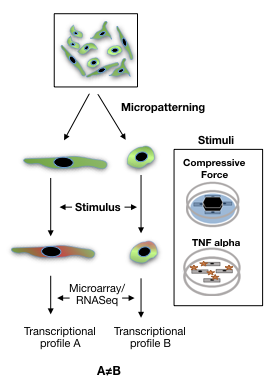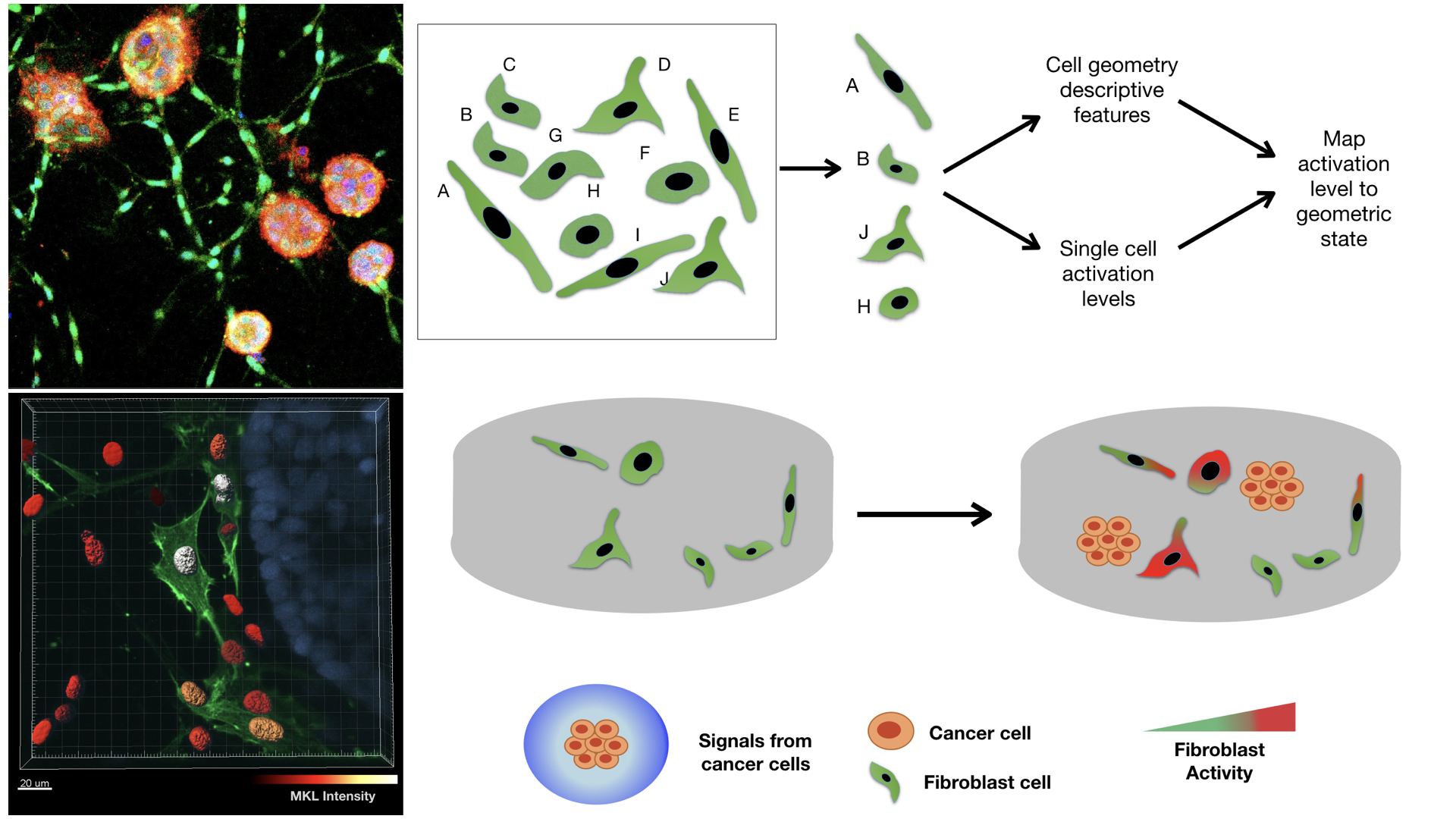Cell shape modulates cellular response to stimuli
Demonstrated that the cell shape can modulate the transcriptional response to external stimuli such as compressive load and inflammation.
Paper1 Paper2 
Demonstrated that the cell shape can modulate the transcriptional response to external stimuli such as compressive load and inflammation.
Paper1 Paper2 
Established the existence of activation primed cell shapes using multimodal-multivariate analysis. Demonstrated a causal relationship between cell geometry and activation. In addition, our study presents a framework for studying single cell heterogeneity and highlights the importance of the geometric state of fibroblasts in the interpretation of environmental signals.
Paper Poster 
Radhakrishnan AV, Jokhun DS, Saradha Venkatachalapathy, and Shivashankar GV
Published in Biophysical Journal, 2017
This paper explores how the positional dynamics of the nucleus is modulated in cells of different shapes
Mitra A, Saradha Venkatachalapathy, Ratna P, Wang Y, Jokhun DS, and Shivashankar GV
Published in Proceedings of the National Academy of Sciences, 2017
In this work we demonstrate cells of different shapes respond differently to inflammatory cues PaperScience Feature
Belyaeva A,Saradha Venkatachalapathy, Nagarajan M, Shivashankar GV, and Uhler C
Published in Proceedings of the National Academy of Sciences, 2017
This study demonstrates that the inter chromosomal contacts are crucial elements of transcription regulation.
Roy B, Saradha Venkatachalapathy, Ratna P, Wang Y, Jokhun DS, Nagarajan M, and Shivashankar GV
Published in Proceedings of the National Academy of Sciences, 2018
In this paper we describe a novel method of reprogramming fibroblasts to iPSC-like cells.
Damodaran K#, Saradha Venkatachalapathy#, Alisafaei, Radhakrishnan AV, Sharma Jokhun D, Shenoy VB, and Shivashankar GV (#Equal contribution)
Published in Molecular Biology of the Cell , 2018
In this work we show that when given the same compressive force stimulus, cell of different shapes have different transcriptional response
Saradha Venkatachalapathy, Doorgesh Sharma Jokhun, and G. V. Shivashankar
Published in Molecular Biology of the Cell, 2020
In this study, we map fibroblast cell shapes to their activation level and demontrate a causal relationship between the two.
Karren Dai Yang, Karthik Damodaran, Saradha Venkatachalapathy, Ali C Soylemezoglu, GV Shivashankar, Caroline Uhler
Published in PLoS computational biology, 2020
This paper presents an approach to model lineages from images:ImageAEOT.
Karren Dai Yang, Anastasiya Belyaeva, Saradha Venkatachalapathy, Karthik Damodaran, Abigail Katcoff, Adityanarayanan Radhakrishnan, GV Shivashankar, Caroline Uhler
Published in Nature Communications, 2021
This paper presents an approach to translate between data modalities via a shared latent space
Published:
Poster presentation at Biophysical Society-MBI Thematic Meeting: Mechanobiology of Disease
Authors: Radhakrishnan AV,Saradha Venkatachalapathy,Shivashankar G.V.
Abstract
The collective activity of several molecular motors and other active processes generate large forces for directional motion within the cell and a background of fluctuating forces. These processes are vital for a multitude of cellular functions such as migration, division and contraction. In addition, they can also influence the transport and positioning of many cellular organelles by affecting their intracellular dynamics. This creates unique biophysical signatures which are altered in many diseases. In this study, we have used the nucleus as a probe particle to understand the micro-rheological properties of the cytoplasm by using micropatterning techniques to confine cells in two structurally and functionally extreme geometries. We find that nuclear positional dynamics is sensitive to the cytoskeletal organization by studying the effect of actin polymerization, nuclear rigidity, and TNFα cytokine stimulation on the position and diffusive behavior of the nucleus. Taken together, our results suggest that mapping nuclear positional dynamics provides important insights into biophysical properties of the cytoplasm. These biophysical signatures could also be used as an ultrasensitive single-cell assay for early disease diagnostics.
Published:
Gave a talk at the 3rd International Symposium on Mechanobiology
Published:
Gave a talk at EMBO Workshop: Nuclear Mechanogenomics
Published:
Poster presentation at Mechanobiology after 10 Years: The Promise of Mechanomedicine
Authors: Saradha Venkatachalapathy,Shivashankar G.V.
Published:
Talk and poster presentation at International Conference on Genomes and AI: From Packing to Regulation”
Published:
Gave a talk at ELRIG’s :Drug Discovery 2019 – Looking Back To The Future
Published:
Talk and poster presentation at 64th Annual Meeting of the Biophysical Society
Undergraduate course, University 1, Department, 2014
This is a description of a teaching experience. You can use markdown like any other post.
Workshop, University 1, Department, 2015
This is a description of a teaching experience. You can use markdown like any other post.